
Wouldn’t it be sweet if a single activity could improve mental and physical health, boost quality of life, cost next to nothing, and be a downright pleasure to boot? The humble act of gardening, it seems, holds all of these benefits with a downside no greater than a little dirt under the fingernails.
The beauty of it is that gardening in some form is available to us all. Whether we’re seeking a crop of edibles, an ephemeral cluster of blossoms, or a task to quiet the mind, it hardly matters: a garden delivers on so many levels. Being out of doors in the company of plants might be just what the doctor ordered! Consider these advantages.
Contact with nature
Science is catching up with what many of us have long known intuitively: humans are healthier when they spend time in the natural world. With roughly 81 percent of Canadians living in towns and cities, regular access to pure wilderness can be hard to come by.
But nature in its many urban forms is all around us—non-human species living out their processes and relationships; the weather and seasons touching every yard and alley. Gardening gets us up close and personal with not only the plants but also the insects, birds, soil, and even minerals that go hand in hand with them.
Healthy mind
We don’t immediately think of gardening as an intervention for depression and anxiety, but studies show it can function in exactly that way. In fact, time spent among and tending plants is considered an official mental health treatment: horticultural therapy.
Horticultural therapy
The healing power of gardening is considered so effective that an entire field of psychological treatment has been built around it.
Mitchell Hewson, a leading horticultural therapist at the Homewood Health Centre in Guelph, Ontario, describes the therapy this way: “Its positive effect on clients, including those who suffer from post-traumatic stress, dementia, addictions, and other forms of mental illnesses, are borne out by both anecdotal and empirical evidence. Through the use of ‘living’ materials—flowering plants, fruits, vegetables, and herbs—horticultural therapy stimulates thought, exercises the body.
There’s a profound sense of accomplishment that comes from stewarding something edible or beautiful to fruition, and plants’ seasonal renewal provides reason for optimism. Gardening also tends to improve self-esteem, overall life satisfaction, and cognitive function. Who wouldn’t like a healthy dose of all three?
Healthy body
In the same way that needing to walk the dog gets us off the couch, plants under our care propel us out into the sun and into regular physical activity. It’s recommended that adults get a minimum of 2 1/2 hours of exercise weekly; gardening is one way to achieve this.
Having an enjoyable way to stay active means that, in addition to our garden crop, we can reap the preventive effect exercise has on chronic conditions such as diabetes and heart disease.
Garden soil itself confers a surprising health perk, as exposure to soil microbes when we’re young is integral to a well-functioning immune system throughout life. And let’s not forget the all-important vitamin D we soak up when we expose our skin to a little sunshine out there!
Family and community
Gardening has its rewards as a solitary endeavour, but it can just as easily open the door to rich friendships and family time. Those who garden in shared plots report an enhanced sense of community and social ties, an important antidote to loneliness. Community gardens are also a source of resilience in the face of the unexpected, such as natural disasters.
And as far as ways for our kids (and grandkids) to pitch in, spend time with us, and engage with the natural world, it doesn’t get much better than plants they can get their hands on, watch grow, and even eat.
Healthy food and finances
Not only is the act of growing our own fruits and vegetables good for us, but consuming them is too. Associated with everything from better vision to decreased risk of chronic illness, a fruit- and vegetable-rich diet is easy to adopt when the products are close at hand, at their freshest and most flavourful.
Both children and adults are more apt to go for the good stuff when they’ve had a hand in growing it. And as the price of produce continues to rise, gardening can be an important cost-saving measure, allowing us to feed ourselves well on a budget.

Cramped in the city?
Consider these gardening solutions for tight urban living.
- Compact and vertical – plant hanging tomato or strawberry baskets, upright pallets filled with soil, window boxes, or wall-trellised climbers such as peas or beans.
- Raised bed – a tightly contained growing area can be created at an accessible height.
- Use shade – annual or perennial edibles or ornamentals adapted to less sunlight can fill unoccupied shady areas.
- Rooftop – with permission and access, the flat roof of an apartment or workplace can host pots or small raised beds (be sure it can handle the added weight).
- Front yard – sometimes overlooked, front yard space is ideal for those who like to share or socialize with neighbours or passersby.
- Community gardens – join or consider starting one yourself.
- Others’ turf – cultivate a willing neighbour’s extra space, work the garden of a public or private facility or your workplace, or swap help for veggies at a local community-supported agriculture (CSA) farm.
Jackie Skrypnek is a holistic nutritionist, permaculture gardener, and all-round food enthusiast. She creates nourishing breakfasts for the guests at her tiny house B&B in Cochrane, Alberta. hereaboutsbnb.com
This article was originally published in the April 2020 issue of alive Canada, under the title “Gardening’s Good for What Ails You.”

